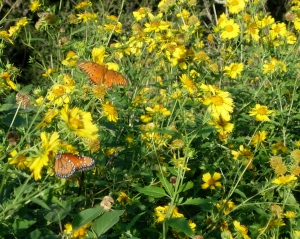Cowpen daisy, one of my favorite butterfly host plants, is busting out its yellow flowers in my front yard. An undersung hero of the butterfly garden, Cowpen Daisy, Verbesina encelioides, is easy to grow, drought tolerant, a fantastic nectar source for many kinds of butterflies, and the host plant to the adorable Bordered Patch butterfly.
The Ladybird Johnson Wildflower Center native plant database notes that Cowpen Daisy is also called Golden Crownbeard. “A well-branched grayish-green plant with mostly opposite, toothed, nearly triangular leaves and yellow flower heads. The flower heads are up to 2 inches (5 cm) across and have 3-toothed rays. The silvery green leaves are triangular with toothed margins.” I couldn’t have said it better myself.

Cowpen Daisy seed collected in November 2010
I love this plant. It will grow anywhere, thrives in the heat, and doesn’t need much water–the perfect low maintenance butterfly host and nectar plant. You can keep it tidy with trimming or allow it to grow bushlike, up to five feet tall and three feet across.
Some disdain its wily ways and sometimes unkept appearance. Others look down on its indiscriminate choice of soil. It’s well-known for
promiscuously spreading its seed and germinating freely in disturbed situations.
But I take all that as a plus. For the busy gardener with limited time and a frugal watering schedule, Cowpen Daisy delivers. You may recall me writing about collecting Cowpen Daisy seeds in the wild late last fall. Those seeds were planted in trays, germinated, given a haircut and thinned, and were then transplanted into the garden. There they thrive.
As summer heats up, Cowpen Daisy will flourish. Bordered Patch, Gulf Fritillaries and Painted Ladies will soon light on its yellow petals. Later in August the Queens and Monarchs will return to slurp up its nectar. I look forward to their arrival.



I started out gardening thinking Roses would attract all the bees and butterfly. How so wrong I was. Its been a journey for me to discover all natives and what a joy it is to see all the little natives that I have now attract sooooo much of Bees/ Butterflys. Its been a journey and your website along with Lady Bird Johnsons web site have been eye openers. I make it a point to let all my friends know look you all up and have started talking to my HOA too. HOA’s dont realize they can get so much from so little in landscaping $$ and get help nature
I retired in the hot/dry central Texas hill country near Richland Springs. Built our house and shop, did landscaping with low maintenance plants and had this pesky plant pop up here and there around my place. I found the large sunflower like flowers were very popular with bees and butterflies . Last fall when the plants dried out, I pulled them up and shook the seed heads around some very large landscape stone I had placed in my front yard. The next spring they started to grow and finally covered all of the small car size rocks. When they started blooming they exploded with tons flowers. Late summer I thought they were done and was going to pull them up but we got a nice rain and they took off again with tons of flowers. They are the best attractors of bees and butterflies for me since they are very drought tollerent. Also I have been seeing lots of quail. It is now my favorite flower. I am spreading them all over my 30 acres .
Thanks